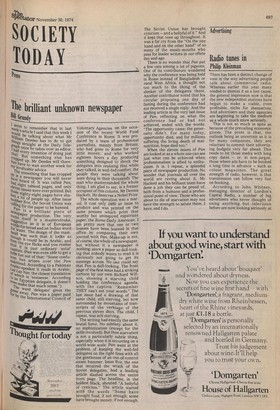Radio tunes in
Philip Kleitunan
There has been a distinct change of tone in the way advertising people talk about commercial radio. Whereas earlier this year many tended to dismiss it as a lost cause, the general impression now is that the new independent stations have begun to make a viable, even profitable, niche for themselves. And advertisers and their agencies are beginning to take the medium as a whole much more seriously.
This is not so much in spite as because of the prevailing economic gloom. The point is that, the outlook being as uncertain as it is for many companies, they are reluctant to commit their advertising budgets very far ahead. This tends to hit those media with long copy dates or, in non-jargon, those where ads have to be booked a long time in advance such as colour magazines. The great strength of radio, however, is that transmission can follow very fast on booking.
According to John Whitney, managing director of London's Capital Radio, a number of big advertisers who never thought of using anything but television before are now looking seriously at radio, He thinks, though not all media-buyers agree, that the mere cheapness of radio time gives it a great advantage in times like these.
Capital, though it still isn't making a profit, claims to be selling over 75 per cent of its available advertising time on weekdays between 6 a.m. and midnight. The London Bitadcasting Company news station is selling between 65 and 70 per cent of its time.
Like Capital, LBC is still losing money but, again like Capital, it hopes to get into the black some time in the not too distant future if present trends continue. Apart from advertising, LBC enjoys an increasing source of revenue in the syndication fees paid to its Independent Radio News subsidiary by the other commercial stations. Nine stations are already in existence, and ten more are still to come.
However, it is not in London but in the provinces that the real radio success stories are to be found. Three of the provincial stations — Radio Clyde in Glasgow, Radio Piccadilly in Manchester and BRMB in Birmingham — claim to be making profits. Clyde's success, in particular, has been spectacular. An NOP survey gave it a daily audience of 875,000 and it has ,become a local force to be reckoned with.
The size of the commercial radio audience has been a bone of contention since the BBC claimed in September that it amounted to less than a million a day. This figure was based on the Corporation's own continuous national audience survey, in which 2,000 people are interviewed each day about their listening behaviour.
The BBC has now increased its estimate to 1,500,000, but these figures are strongly disputed by the Association of Independent Radio Contractors, which points out that the Corporation's research is not really adapted to accurate measurement of audiences in particular regions.
According to the AIRC, the total daily commercial radio audience is probably over five million (including a million for Capital, 500,000 for L.B.C, 750,000 for Birmingham and 800,000 apiece for Manchester and the new Radio City station in Liverpool).
Some of these figures are either out-of-date or unverified. Much interest, therefore, attaches to the results obtained from the new E90,000 contract between the Association and the RSGB research company, covering the whole country. During its contract period, which runs until the end of next year, RSGB will be issuing audience figures based on the diary system, under which a sample of people record their listening. The first RSGB survey figures will be out next week and will cover the London area. The Manchester result will also be out before Christmas.
In the end, of course, it is the confirmed size of the audience which will decide the big national advertisers (as distinct from the local retailers) whether radio is worthwhile. It is probably only when such advertisers put .their money into national radio campaigns that the long-suffering London stations will reap the full benefits of their patience.











































 Previous page
Previous page